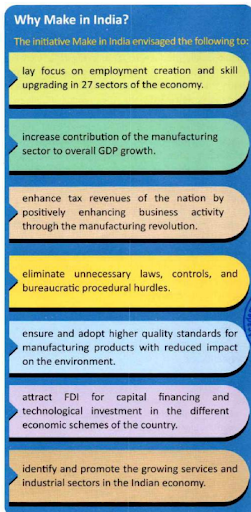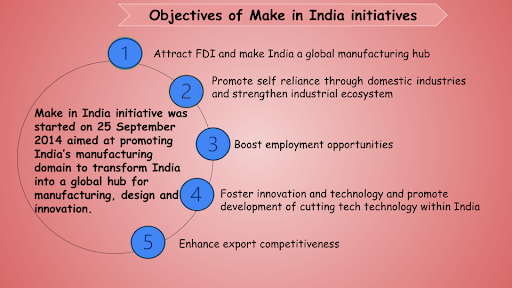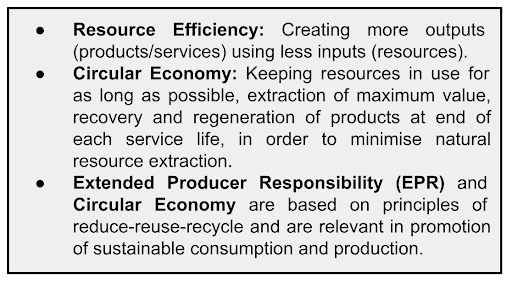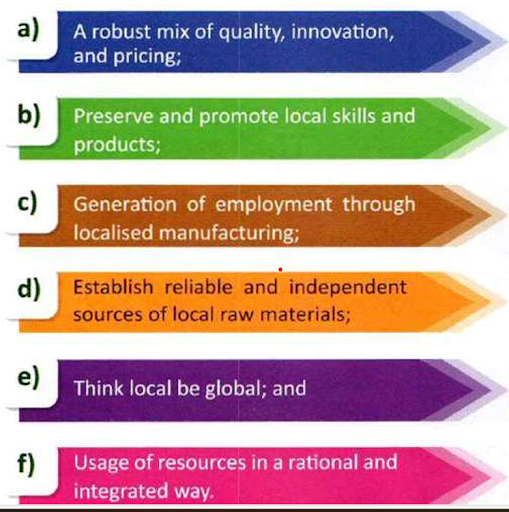Kurukshetra Magazine is a vital source of study material for the UPSC IAS exam. It is a monthly magazine that gives information about important government schemes and programmes in various sectors. Kurukshetra is an authentic source of information for the UPSC Exam. Here, we provide the Gist of Kurukshetra, exclusively for the IAS Exam.
Gist of Kurukshetra September 2023
Download PDF Here
TABLE OF CONTENTS
1. Make in India - Challenges, opportunities and Outcomes 2. Changing Paradigm of Foreign Direct Investment 3. Fostering Skills for Environmentally Conscious Sustainable Future 4. Transforming Manufacturing 5. Leveraging Vocal for Local
1. Make in India – Challenges, opportunities and Outcomes
The Government of India launched the Make in India initiative on 25 September 2014 aimed at promoting India’s manufacturing domain to transform India into a global hub for manufacturing, design and innovation.
Considering the importance of the manufacturing sector, the Make in India initiative is built on four pillars:
- New Process:
- Ensuring an enabling environment to attract both domestic and foreign investment.
- Improving the ease of doing business to promote entrepreneurship.
2. New infrastructure:
- Developing industrial corridors, smart cities, and high-speed communication network amenities.
- Simplifying procedures for registering intellectual property rights.
- Providing training and education to create a skilled workforce.
3. New sectors:
- 27 sectors in both manufacturing and service sectors to be covered under the Make in India initiative.

| Manufacturing Sector | Service sector |
|
|
- New mindset:
- Encouraging the government’s partnership in economic development to foster ownership.
- Fostering the development of the corporate sector.
Advantages of Make in India
- Creating a virtuous cycle through employment generation:
- Increasing employment opportunities, both in rural and urban areas, will increase people’s purchasing power thereby expanding the consumer base, attracting more investment, generating more employment and addressing poverty.
- Reducing Brain Drain:
- Improved education, training, and high-paying skilled jobs help reduce brain drain.
- Improving Balance of Payments (BoP):
- Focus on export-oriented manufacturing processes improves the BoP position of the country.
- Attracts Foreign Direct Investment (FDI)
- Inflow of technical expertise:
- The inflow of FDI and the setting up of manufacturing hubs will lead to an inflow of technical expertise on advanced technologies.
Challenges in Make in India

Image: Challenges in the Make in India initiative
Balanced Regional development:
- The “One District One Product” program promoted under ‘Make in India’ aims to promote the production of indigenous products from each district, fostering balanced regional development.
Impact of the Make in India Initiative:
- Ease of Doing Business:
- India’s ranking improved to 63 in 2022, compared to 142 in 2014.
- Foreign Investment:
- India saw the highest annual inflow of FDI at $84.84 billion in FY 2022.
- Gross FDI in India grew to 2.6% of GDP during FY 2015 and 2022.
- Agriculture Sector:
- Export of agriculture and allied services grew by 18% in 2020-21 over 2019-20, reaching a high of USD 50.2 billion in 2021-22.
- Manufacturing Sector:
- Despite COVID disruptions, there was an increase in employment from 57 million in 2017-18 to 62.4 million in 2019-20.
- Positive growth in gross value addition in the manufacturing sector.
- Service Sector:
- Service exports grew by USD 48.4 billion in 2021-22 over 2020-21.
As a long-term sectoral intervention, the Make in India initiative has the potential to transform India into a world manufacturing hub. Care must be taken to ensure balanced regional growth and address issues of poverty, unemployment, and income and wealth disparities.
2. Changing Paradigm of Foreign Direct Investment
- The International Monetary Fund (IMF) defines Foreign Direct Investment (FDI) as the acquisition of at least ten per cent of ordinary shares or voting power in a public or private enterprise by non-resident investors.
- In simpler terms, FDI refers to foreign companies or individuals investing in a host country to establish or expand their business operations.
- There are two types of FDI:
- Horizontal FDI: This involves investments to produce the same or similar goods in the host country as in the home country, driven by factors like profitability and lower labour costs.
- Vertical FDI: It aims to exploit raw materials or be closer to consumers by acquiring distribution outlets, leading to cost-effective production.
- FDI methods include Greenfield investments, Mergers and Acquisitions, and Joint Ventures.
- Recent research indicates an inverted U-relationship between a country’s income level and FDI’s impact on growth.
- Impact is more significant as a country moves from low to middle income, but diminishes as it becomes a higher-income nation.
FDI in India
- In India, FDI enters through three main routes:
-
- Automatic Route: Foreign investors can invest without prior government approval.
- Government Route: Foreign investors require government approval in cases where there are strategic interests.
- Merger and Acquisition: Foreign companies acquire existing Indian companies.
- FDI in India has seen steady growth since 2005, increasing from 0.7% of GDP to over 2.4% by 2020.
- Top countries with FDI investment in India in 2022-23 include Mauritius (26%), Singapore (23%), the USA (9%), the Netherlands (7%), and Japan (6%).
Image: Inflow of FDI

Source: Kurukshetra
Image: FDI as a percentage of GDP

Source: Kurukshetra
| Sectors | FDI reforms undertaken |
| Single-Brand Retail Trading (SBRT) | 100% FDI allowed under the automatic route, with relaxed local sourcing norms for inputs. |
| Construction sector | Minimum capitalization requirement was lowered from USD 10 million to USD 5 million. |
| Digital media | 26% FDI allowed under the government route. |
| Coal mining and civil aviation | 100% FDI allowed under automatic route. |
| Defence sector and Insurance sector | FDI limit increased from 49% to 74% under automatic route. |
| E-Commerce | Restrictions on exclusive deals, inventory control, and equity participation in vendors on platforms. FDI is not allowed in inventory-based models. |

Impact of FDI in India’s Manufacturing Sector and Make in India
- Annual FDI inflow into India has increased considerably with the launch of the Make in India initiative.
- FDI supports the Make in India program by providing the necessary capital, technology and expertise to set up modern and efficient manufacturing units.
- The manufacturing sector in India contributes about 17.3% of India’s Gross Domestic Product (GDP) and employs around 12% of the country’s workforce.
- The automobile industry experienced remarkable growth, with a 25.47% increase from 2017-18 to 2018-19, coinciding with a substantial FDI equity inflow of 2.09 billion USD.
- Similarly, the textile sector attracted significant FDI investments totalling 1522 million USD from 2017 to 2022. This sector contributes 4% to India’s total GDP and accounts for over 14% of the country’s export earnings.
FDI plays a pivotal role in bridging the gap for emerging economies by providing capital and technological support for industrial development and driving economic growth.
3. Fostering Skills for Environmentally Conscious Sustainable Future
- Green jobs, as defined by the International Labour Organisation (ILO), are decent jobs contributing towards the preservation or restoration of the environment, whether in traditional sectors like manufacturing/construction or in new/emerging sectors such as renewable energy and energy efficiency.
- As per ILO, green jobs help in:
- Improvement of energy and raw materials efficiency
- Limits emissions of greenhouse gases (GHGs)
- Minimisation of waste and pollution
- Protection and restoration of ecosystems
- Supports adaptation to climate change effects
- Green skills, according to the United Nations Industrial Development Organisation (UNIDO), are knowledge, abilities, values, and attitudes that are needed for living in, developing, and supporting a society that is sustainable and resource-efficient.
- Green Skill Development Programme (GSDP): Under this, the Union Ministry of Environment, Forests, & Climate Change (MoEF&CC), by utilising the ENVIS Hubs’ expertise and wide network, is enabling India’s youth to get employment through skill development in environment and forest sectors.

- It is regularly aligned with NCVET guidelines and norms.
- All courses under it are NCVET-approved.
- Beneficiaries:
- School and college dropouts
- Students in the environmental sector
- Entrepreneurs
- Working professionals (including those in industries)
- Technical and scientific institutions
- National Action Plan on Climate Change (NAPCC): It is India’s national strategy for adapting to climate change and enhancing the ecological sustainability of the development path. It has eight missions for a long-term and integrated approach.
Image: NAPCC Missions

Source: Green Clean Guide
- Panchamrit Strategy: India presented this strategy at the 26th Session of the Conference of Parties (CoP 26) to the UN Framework Convention on Climate Change (UNFCCC).
Image: India’s Panchamrit Strategy

Source: The Hindu Businessline
- As part of the United Nations Decade of Action for Sustainable Development Goal (SDG) attainment, several measures have been initiated by India for Resource Efficiency and Circular Economy, including waste management and prevention.

- Committees for the development of circular economy action plans have been constituted by the NITI Aayog.
- MoEF&CC
- Nodal Ministry for Circular Economy Action Plan for Tyre and Rubber.
- Notified ‘Guidelines on the EPR for Plastic Packaging’ under Plastic Waste Management Rules, 2016.
- Aims to foster a circular economy approach while moving away from a linear economy under the draft National Resource Efficiency Policy, 2019.
- Bio-briquetting: An off-farm sustainable technology which can be used to generate biomass energy from pine needles.
- G B Pant National Institute for Himalayan Environment (an autonomous body under MoEF&CC) is promoting the manufacture of bio-briquettes and bio-globules among marginalised groups of villagers, leading to better resource utilisation and generating livelihood.
- The Department of Science and Technology (DST) along with the Ministry of Education is promoting R&D in environment-friendly and sustainable technologies and areas.
- DST is supplying these technologies to Make in India to balance environment and development.
- PARIVESH (Pro-Active and Responsive facilitation by Interactive, Virtuous and Environmental Single-window Hub) has led to the automation of the process of granting environment/forest/wildlife clearances for developmental projects.
4. Transforming Manufacturing
- Make in India initiative: Introduced in 2014 by the Government of India (GoI).
- It seeks to transform India into a manufacturing hub.
- It is a multifaceted initiative with primary objectives of domestic manufacturing promotion, foreign investment attraction, innovation encouragement, and opportunity generation.
- Ease of doing business is an important component for which GoI has taken measures to streamline regulations, simplify licensing procedures, and create an investor-friendly environment.
- Fostering innovation and entrepreneurship enhances the competitiveness of Indian industries.
- Provides market access to manufacturers.
- It acts as a boon for innovators because:
- Creates an environment which nurtures innovation and provides support
- Financial incentives for those seeking to establish manufacturing/R&D centres
- Access to cutting-edge technology because of technology transfer and collaboration between Indian and global firms
- Global recognition
- Manufacturing sector in India: Prior to the pandemic, around 16-17% of India’s GDP was contributed by the manufacturing sector.
- It provides employment to over 27 million people.
- India is targeting 25% of the economy’s output from the manufacturing sector by 2025 seeing its rapidly growing potential, reaching around US$ 1 trillion by 2025.
- As per the Indian Cellular and Electronics Association (ICEA), through strategic policy interventions, India can achieve US$ 100 billion by 2025 by expanding its laptops and tab cumulative manufacturing capabilities.
- The total revenue of the Indian tech industry in 2022 is US$ 227 billion.
- The Indian startup ecosystem boasts 108 unicorns signifying innovation and entrepreneurship promotion.
- Global Partnership on Artificial Intelligence (GPAI): International initiative dedicated to the promotion of responsible and human-centric development and utilisation of AI.
- India is one of the founding members of the group which it joined in 2020, and is one of 25 member countries.
- Sectors Pushing ‘Make in India’ Programme
- Automotive Sector: The current value of this sector is US$ 74 billion and the industry has set a target of US$ 300 billion by 2025, creating an additional 65 million jobs.
- Renewable Energy: India has become one of the leading solar energy producers, contributing greatly to the global energy transition.
- Electronics Hardware Manufacturing: India aims to achieve self-sufficiency, create jobs, and attract FDI through local production.
- The sector aims to reach a turnover of US$ 400 billion, creating 28 million jobs, and increase exports to US$ 80 billion.
- Food Processing: It can become a sunrise sector in India. The Union Ministry of Food Processing Industries, under the Make in India, supports 135 integrated cold chain projects and has operationalised 7 Mega Food Parks (MFPs).
- Each MFP can generate 5000 jobs and can benefit 25000 farmers.
- AI & Robotics: AI & Robotics Park in Bengaluru backed by Rs. 230 crore seed capital.
- US$ 100 million venture fund established by ARTPARK and AI Foundry for promoting innovation in these fields in India.
- Open Network for Digital Commerce (ONDC): It was launched to establish a digital commerce ecosystem.
- It advocates for local innovation and production, empowering enterprises and entrepreneurs, and contributing to overall economic growth.
5. Leveraging Vocal for Local
Amidst the crisis of the COVID-19 pandemic, ‘vocal for local’ has emerged as a new path for development. A robust ‘vocal for local’ framework can strengthen the rural economy and usher the Indian economy towards the path of becoming the third largest economy in the world.
The Rationale for Vocal for Local:
The COVID-19 pandemic has led to agrarian distress, rising youth and educated employment and a decline in female labour participation. In the wake of this, ‘vocal for local’ could be a key driver for a self-reliant India.
- Inclusive growth, rural transformation and steady recovery are the primary objectives of the “vocal for local” call. The larger objectives are to encourage the development of rural areas in line with Mahatma Gandhi’s vision of self-sufficient and self-reliant communities based on local resources and employing decentralised, eco-friendly technologies so that the basic needs are met locally.
- The ‘Vocal for Local’ strategy aims to make local products competitive with those of international brands by promoting local production, supply networks, and brands in addition to Make in India. The fundamental idea behind this is to help and promote small businesses with constrained resources and markets.
- The strategy aims to help and encourage small businesses with constrained resources and markets. Additionally, “Vocal for Local” would tend to encourage Indians to develop a taste for buying and consuming local items.
- The Ministry of Textiles has tied up with India Post to leverage 4,00,000 Common Service Centres (CSCs), which have been primarily set up to offer government e-services to enable artisans to go online with their products and become competitive.
Framework to leverage ‘Vocal for Local’:
- A comprehensive profiling or mapping of local resources and demand and supply at the village level should be the starting point of this strategy.
- Panchayats in coordination with other stakeholders can create a system of visiting local businesses periodically to discuss their needs, challenges, and opportunities and also helping both aspiring and existing enterprises to get benefits from schemes and programmes.

- Gram Panchayat Development Plan (GPDP) can play a direct role in identifying sectors, sub-sectors, and activities by their respective business potential and devise a mechanism to prioritise resource allocation.
- A robust convergence framework is required to strengthen ‘Vocal for Local’. Efforts must be made to connect entrepreneurs, SFURTI, Van Dhan Vikas Kendra, One District One Product (ODOP), Cluster Development Programme (CDP), Common Facility Centres (CFCs), etc.
- Community Resource Persons (CRPs) such as Kisan Sakhi/Krishi Sakhi, Pasu Sakhi (Livestock CRP), Doctor Didi, Enterprise Promotion (CRP-EP), Bank Mitras, e-CRPs, etc., have key responsibilities of making the benefits available to their intended beneficiaries.
- Hence, the training and capacity building of these CRPs need to be improved on a regular basis in order to inform them about changes in policies and programmes and to teach them new skills that will help them implement both on-farm and off-farm livelihood schemes more successfully.
The ‘Vocal for Local’ developmental strategy has the ability to encourage self-sufficiency, spur economic expansion, create opportunities, lessen dependency on imports, and provide the nation’s small, micro, and SHG-based businesses a much-needed boost.
| Related Links | |||
| Skill India Mission | Challenge of Skills And Jobs | ||
| Green Finance | Digital India | ||
| Pradhan Mantri Jan-Dhan Yojana (PMJDY) | Green GDP | ||
Comments